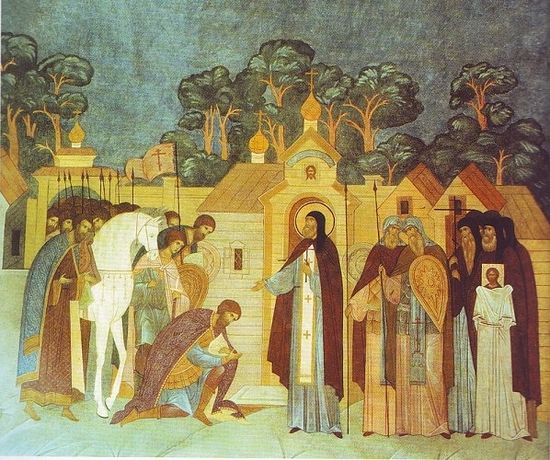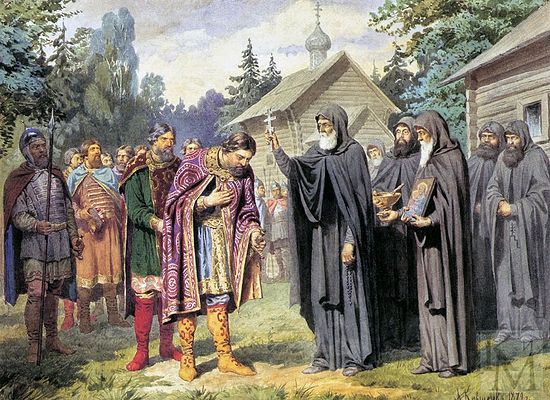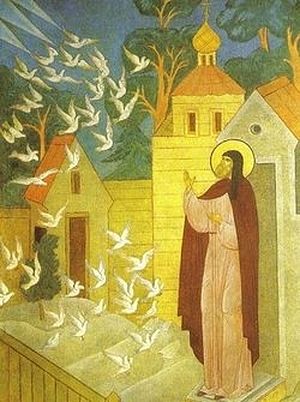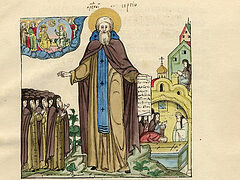Representative of the Synodal Information Department V. R. Legoida speaks in an interview with “The Russian Idea” on the importance of this great saint for the establishment of Russian statehood, the development of Russian monasticism and Church institutions in the context of modern Church-state relations.

—How would you evaluate the role of St. Sergius of Radonezh in forming the Russian state and the development of monasticism and Church institutions? Can we consider him a religious philosopher or theologian?
—There is a well-known expression: “He who prays is a theologian.” From this point of view Venerable Sergius is, undoubtedly, a theologian, although not in an academic sense, as we don’t know any of his texts, with only a few phrases coming down to our time. Also, of course, he can hardly be called a religious philosopher in the conventional sense. But he, I repeat, was a theologian in the highest sense of the word. The continuity of the tradition of hesychasm is obvious in this saint’s prayerful monastic podvig. As His Holiness Patriarch Kirill recently noted, “the practice of hesychasm by Venerable Sergius and his disciples became a spring gathering the people in a single spiritual whole, which subsequently received the designation ‘Holy Rus’”[1]… Indeed, the emergence of Russian spiritual culture and Russian culture in general, and Holy Rus’ as a cultural ideal and as the center of values (existing in the cultural space today), is, undeniably, connected with St. Sergius. We can’t say with him alone, but with him in the first place.
As regards the development of monasticism—the saint left the world, left for the forest, and people began to come to him, and then a lavra arose. In this way, a tradition was formed which distinguishes Russian monasticism, we can say, from ancient Orthodox monasteries. It would be difficult to reprove Russian monasticism for non-traditionalism, but it differs from the habitations of the early Christian anchorites: the first people left the world and had no more contact with the world, in which, essentially, was found the point of leaving. And St. Sergius, on one hand followed this tradition, and on the other… Russians can’t imagine not being allowed to go to a monastery unless you’re a monk. St. Sergius established a new model of cooperation between the monastery and the world, from which, by the way, arose the phenomenon of Russian eldership. Monks leave the world but the world leaks into the monastery—for spiritual direction, for help, for solace. People of various classes, of various spiritual and cultural needs found answers to their numerous questions within the walls of Optina Pustyn in the nineteenth century. All of this is also in large part the heritage of the abbot of the Russian land. By the way, it’s been repeatedly noted that only St. Sergius is given this name: not the abbot of the Lavra, but of the whole Russian land.
Regarding the Russian state—as is known, Russian political culture has such a characteristic: the people and the state, the nation and the state are not so rigidly differentiated, as, for example, in the political culture of America. The concept of the state as a group of people hired by the people and serving the people, is not really native to Russian political culture. This, of course, can be viewed in different ways. But if you approach it objectively, then traditionally, there are requirements that apply to those who run the government, not simply as to officials who we hired to serve us. And here there’s even a fundamentally different semantic: “statesmen” are absolutely not the same as “effective managers”… This understanding is also connected with the time of St. Sergius, although to us it’s totally obvious that the times have changed, and the relationship of the Church and state has changed repeatedly. Institutionally the modern state hardly reminds us of the princedom of the fourteenth century. But political culture as a system of value orientations still largely feeds on that which took shape in the time of Venerable Sergius.
—As is known, St. Sergius took part in the reconciliation of princes, and persuaded them to march out with St. Dimitry Donskoy. Did he somehow contribute to the strengthening of the Church and the growth of its authority?
—That’s a question a bit “from the outside.” In what lies the particular importance of this saint? He was a Christian, that is, a man who tried to lived according to the Gospel, and we see that he managed in full measure. His life, his hagiography is a resplendent illustration of that principle which, centuries later, was succinctly articulated by another famous Russian saint, Venerable Seraphim of Sarov—“Acquire a spirit of peace and thousands around you will be saved.” Why did rugged soldiers begin to listen to this man—a man who came out from somewhere in the woods? Why did St. Dimitry Donskoy go to St. Sergius? What was he to the prince that he listened when he suggested to first go to church, and then make his fateful decision? Speaking of the importance of St. Sergius’ activity for societal life, we must understand, above all, what precisely was his own, as we would say today, motivation. What was important to him? For him it was important that life could be lived as the Gospels say—to defeat evil within oneself, to help others overcome evil, to defeat evil in relationships with others, and to overcome the “hateful discord of this world.”
—But it coincided with the general movement towards strengthening the Church, which, came out in support of the Muscovite princes and began to acquire precisely a political authority.
—It’s difficult for me to agree with such political formulations. What was political authority at that time, in the fourteenth century, when religion and politics were not differentiated to such an extent as is the case today? We’re talking about a completely different period, when in the cultural sphere (in the broad sense) there was as yet no religious and political differentiation. This was still centuries before the formulation of the principle of separation of church and state, and there was as yet no phenomenon or concept of a “nation-state.”
What is “political?” In the ancient world political and religious were for the most part practically identical. Which was more important in the deification of the Roman Empire: the religious or the political? Therefore, your given question, as it seems to me, somewhat simplifies the situation and doesn’t completely correctly describe the social ontology of the time.
—Is such a union of Church and state needed today? That’s on the one hand. And on the other, are there today such people who by their domestic service contribute to the elevation of the Church’s authority? Is it necessary? Or is it just the affairs of bygone days?
—Today we often recall the ideal of the Byzantine symphony, but with the qualification that it was always just an ideal. Practice always differs from theory—in Rus’ and later in Russia, and even in Byzantium where it was first formulated—nevertheless, I think it is important for understanding Church-state relations in our culture.
It’s clear that the Byzantine ideal of a symphony presupposes as a whole an Orthodox society in which there is an Orthodox sovereign personifying state authority, and the Church with spiritual authority. Therefore, it’s impossible to simply impose it upon the modern world; it’s incorrect. But there’s a word that can be used to characterize the relationship between the state in modern Russia and in a few other countries canonically under the Russian Orthodox Church, especially countries that were part of the cultural space of historical Russia: cooperation. In my opinion it is quite correct and perfectly appropriate.
Yes, the Church and state are separate and independent from one another in the modern situation. The state doesn’t dictate to the Church the internal laws of its life, formally coming into contact with it only in the legal field (we can say that the Church, as a social organization, should be registered). But the Church is also independent: the state doesn’t dictate rules as those, for example, it dictated in Soviet times, or even as it did in the so-called Synodal period, when the canonical tradition of the patriarchate was broken. Meanwhile, the Church doesn’t interfere in politics, and has no status as a state Church with all its ensuing features.
The cooperation of today is largely a result of the twentieth century in the sense that today the government, generally, (of course authority is a complex reality, speaking of politics in general, including of the various branches and institutions of government and political parties) has turned towards the Church and other traditional religions of Russia. The original premise of this turnaround is connected, as it seems to me, with the recognition that everything that happened with the Church in the twentieth century—all the persecution—was a tragic mistake—unacceptable and appalling.
Does that mean that today’s relationship of the Church and state is always and in everything infallible? No, it doesn’t mean that, but the shift is obvious. Moreover, the Church is the natural ally of any state, in the good orientation of the tasks standing before it. The Church helps the state to more effectively implement such functions which are aimed at safeguarding the freedom and dignity of man. In our case, in Russia, Orthodoxy has a tradition of a particular relationship to the law, of behavior in agreement with the law. It would be wholly natural if the government would lean on this tradition in battle, for example, with the legal nihilism of the population.
As for people—each time births its own outstanding personalities.

—Returning to St. Sergius of Radonezh: one of the key moments in Russian history in the fourteenth century was the Battle of Kulikovo Field. Did St. Sergius truly bless St. Dimitry Donksoy for victory? Or is it nothing more than a beautiful story lacking support from reliable sources?
—I’m not a historian, but I know they’re various points of views among professionals. Indeed, there are those who cast doubts on what’s written in The Legend of Mamai. They advance their arguments which, at first glance, can seem quite convincing. But there are serious counterarguments. The purely historical testimonies, the analysis of which is known to us about this time shows that Prince Dimitry received the blessing of St. Sergius of Radonezh. Despite the fact that there are many doubts in this version that are seemingly academic, in fact they turn out to be ideologically biased.
—The 2008 TV show “The Name of Russia” outlined the lack of an historical actor who could be called the undisputed national hero. In your view, why was St. Sergius of Radonezh not in the twelve finalists of this program? Can’t we consider that St. Sergius was one of the spiritual actors with most relevant spiritual legacy for Russia today?
—I well remember this show, including because the then-Metropolitan Kirill of Smolensk and Kaliningrad presented the “winner,” St. Alexander Nevsky, on the show. Why was St. Sergius not one of the twelve finalists? In my opinion it doesn’t reflect the true importance of St. Sergius for us today (of which our whole conversation has been about), for our history and culture, but the level of our knowledge. According to one poll, only 40% of Russian citizens have at least some idea about him. Here only education will help. Missionaries, Church personalities, journalists, teachers—they all must try so that people from the past would cease being just names and pictures in textbooks, and become alive, understandable, and near to us all.





